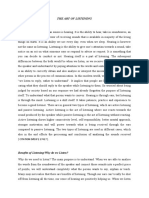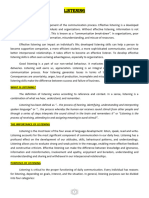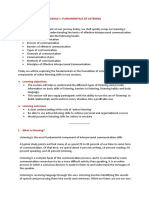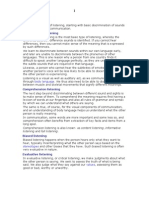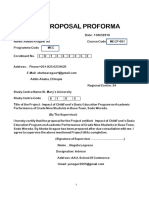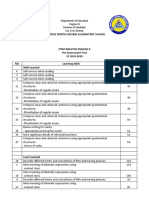Index: Meaning & Barriers EFFECTIVE Listening Tips of Effective Listening Conclusion
Index: Meaning & Barriers EFFECTIVE Listening Tips of Effective Listening Conclusion
Uploaded by
Twinkle AgarwalOriginal Description:
Original Title
Copyright
Available Formats
Share this document
Did you find this document useful?
Is this content inappropriate?
Report this DocumentCopyright:
Available Formats
Index: Meaning & Barriers EFFECTIVE Listening Tips of Effective Listening Conclusion
Index: Meaning & Barriers EFFECTIVE Listening Tips of Effective Listening Conclusion
Uploaded by
Twinkle AgarwalCopyright:
Available Formats
INDEX
TOPICS PAGE NO
Meaning 1
Process of listening 2-3
Types of listening skills 4-6
8-10
Features on listening
Meaning & Barriers EFFECTIVE 11-12
LISTENING
Tips of Effective listening 12
Conclusion 12
Ms. TWINKLE AGARWAL (BBA, MBA) Page 1
Communication Skills Profile
Communication Order Learned Extent Used Extent Taught
Listening First First Four
Speaking Second Second Third
Reading Third Third Second
Writing Fourth Fourth First
Meaning of listening
Receiving information through ears & eyes.
Giving meaning to that information.
Deciding what you think or feel about that information.
Responding to what you hear.
According to Dulay and Burt (1975, p.109) the listening experiences that help
students lessen their anxiety about listening will generally be beneficial, and also is
so important learner´s motives and attitudes about listening, the instructor can better
select input or point learners to the best resources and opportunities for appropriate
input.
I think Listening is the language skill which learners usually find the most difficult; this
often is because they feel difficult to understand every word. To achieve the aims
related to this skill.
Ms. TWINKLE AGARWAL (BBA, MBA) Page 2
Process of listening
Listening is a complex process—an integral part of the total communication process,
a part often ignored. This neglect results largely from two factors.
Hearing
Focusing on the message
Comprehending and interpreting
Analyzing and Evaluating
Responding
Remembering
HEARING - it refers to the response caused by sound waves stimulating the sensory
receptors of the ear; it is physical response; hearing is perception of sound waves;
you must hear to listen, but you need not listen to hear (perception necessary for
listening depends on attention
ATTENTION- brain screens stimuli and permits only a select few to come into focus-
these selective perception is known as attention, an important requirement for
effective listening; strong stimuli like bright lights, sudden noise…are attention
getters; attention to more commonplace or less striking stimuli requires special effort;
postural adjustments are aided by physical changes in sensory receptor organs;
receptor adjustments might include tensing of the ear´s tympanic muscle for better
response to weak sounds
UNDERSTANDING- to understand symbols we have seen and heard, we must
analyze the meaning of the stimuli we have perceived; symbolic stimuli are not only
words but also sounds like applause… and sights like blue uniform…that have
symbolic meanings as well; the meanings attached to these symbols are a function
of our past associations and of the context in which the symbols occur; for
successful interpersonal communication, the listener must understand the intended
meaning and the context assumed by the sender
REMEMBERING- it is important listening process because it means that an
individual has not only received and interpreted a message but has also added it to
the mind storage bank; but just as our attention is selective, so too is our memory-
what is remembered may be quite different from what was originally seen or heard.
Ms. TWINKLE AGARWAL (BBA, MBA) Page 3
EVALUATING- it is a stage in which active listeners participate; it is at these point
that the active listener weighs evidence, sorts fact from opinion, and determines the
presence or absence of bias or prejudice in a message; the effective listener makes
sure that he or she doesn’t begin this activity too soon beginning this stage of the
process before a message is completed requires that we no longer hear and attend
to the incoming message-as a result, the listening process ceases
RESPONDING- this stage requires that the receiver complete the process through
verbal and/or nonverbal feedback; because the speaker has no other way to
determine if a message has been received , this stage becomes the only overt
means by which the sender may determine the degree of success in transmitting the
message.
Ms. TWINKLE AGARWAL (BBA, MBA) Page 4
Types of Listening
Here are six types of listening, starting with basic discrimination of sounds and
ending in deep communication.
Discriminative listening
Discriminative listening is the most basic type of listening, whereby the difference
between difference sounds is identified. If you cannot hear differences, then you
cannot make sense of the meaning that is expressed by such differences.
We learn to discriminate between sounds within our own language early, and later
are unable to discriminate between the phonemes of other languages. This is one
reason why a person from one country finds it difficult to speak another language
perfectly, as they are unable distinguish the subtle sounds that are required in that
language.
Likewise, a person who cannot hear the subtleties of emotional variation in another
person's voice will be less likely to be able to discern the emotions the other person
is experiencing.
Listening is a visual as well as auditory act, as we communicate much through body
language. We thus also need to be able to discriminate between muscle and skeletal
movements that signify different meanings.
Comprehension/ Informative listening
The next step beyond discriminating between different sound and sights is to make
sense of them. To comprehend the meaning requires first having a lexicon of words
at our fingertips and also all rules of grammar and syntax by which we can
understand what others are saying.
The same is true, of course, for the visual components of communication, and an
understanding of body language helps us understand what the other person is really
meaning.
In communication, some words are more important and some less so, and
comprehension often benefits from extraction of key facts and items from a long
spiel.
Comprehension listening is also known as content listening, informative listening
and full listening
Ms. TWINKLE AGARWAL (BBA, MBA) Page 5
Critical listening
Critical listening is listening in order to evaluate and judge, forming opinion about
what is being said. Judgment includes assessing strengths and weaknesses,
agreement and approval.
This form of listening requires significant real-time cognitive effort as the listener
analyzes what is being said, relating it to existing knowledge and rules, while
simultaneously listening to the ongoing words from the speaker.
Biased listening
Biased listening happens when the person hears only what they want to hear,
typically misinterpreting what the other person says based on the stereotypes and
other biases that they have. Such biased listening is often very evaluative in nature.
Evaluative listening
In evaluative listening, or critical listening, we make judgments about what the other
person is saying. We seek to assess the truth of what is being said. We also judge
what they say against our values, assessing them as good or bad, worthy or
unworthy.
Evaluative listening is particularly pertinent when the other person is trying to
persuade us, perhaps to change our behavior and maybe even to change our
beliefs. Within this, we also discriminate between subtleties of language and
comprehend the inner meaning of what is said. Typically also we weigh up the pros
and cons of an argument, determining whether it makes sense logically as well as
whether it is helpful to us.
Evaluative listening is also called critical, judgmental or interpretive listening.
Appreciative listening
In appreciative listening, we seek certain information which will appreciate, for
example that which helps meet our needs and goals. We use appreciative listening
when we are listening to good music, poetry or maybe even the stirring words of a
great leader.
Sympathetic listening
In sympathetic listening we care about the other person and show this concern in the
way we pay close attention and express our sorrow for their ills and happiness at
their joys.
Ms. TWINKLE AGARWAL (BBA, MBA) Page 6
Empathetic listening
When we listen empathetically, we go beyond sympathy to seek a truer understand
how others are feeling. This requires excellent discrimination and close attention to
the nuances of emotional signals. When we are being truly empathetic, we actually
feel what they are feeling.
In order to get others to expose these deep parts of themselves to us, we also need
to demonstrate our empathy in our demeanor towards them, asking sensitively and
in a way that encourages self-disclosure.
Therapeutic listening
In therapeutic listening, the listener has a purpose of not only empathizing with the
speaker but also to use this deep connection in order to help the speaker
understand, change or develop in some way.
This not only happens when you go to see a therapist but also in many social
situations, where friends and family seek to both diagnose problems from listening
and also to help the speaker cure themselves, perhaps by some cathartic process.
This also happens in work situations, where managers, HR people, trainers and
coaches seek to help employees learn and develop.
Dialogic listening
The word 'dialogue' stems from the Greek words 'dia', meaning 'through' and 'logos'
meaning 'words'. Thus dialogic listening mean learning through conversation and an
engaged interchange of ideas and information in which we actively seek to learn
more about the person and how they think.
Dialogic listening is sometimes known as 'relational listening'.
Relationship listening
Sometimes the most important factor in listening is in order to develop or sustain a
relationship. This is why lovers talk for hours and attend closely to what each other
has to say when the same words from someone else would seem to be rather
boring.
Relationship listening is also important in areas such as negotiation and sales, where
it is helpful if the other person likes you and trusts you.
Ms. TWINKLE AGARWAL (BBA, MBA) Page 7
FEATURES OF LISTENING
Focus on Listening
Listen to yourself!
Before you can be an effective listener you have to ensure you are ready to listen.
Assess your mental, physical and emotional states.
Remember you are there to listen!
Many times people in crisis need to talk through their problems, not get advice on
how to solve their problems.
If you aren’t sure if the person wants you to “just” listen or give advice ASK them!
Focus on their concerns
Focus on the person’s train of thought.
Avoid thinking about your response or other non-related things until the person is
finished speaking.
Remove distractions.
If there is a distraction (TV, music, someone else in the room) remove the distraction
if possible so you can focus.
If you can’t remove the distraction, schedule a time when you can focus on their
concerns.
Silence & Body Language
Silence isn’t bad!
Don’t always rush to fill in gaps in conversation. These gaps can be important for the
individual to gather their thoughts or express themselves emotionally.
Listen with your eyes!
People communicate information through behaviors in addition to what they say.
Ms. TWINKLE AGARWAL (BBA, MBA) Page 8
Pay attention to body language to help understand their feelings.
Empathy
Refrain from being judgmental.
Empathy doesn’t mean you agree with the person, just that you have identified and
understand how they are feeling.
Uncomfortable conversations.
If you have difficulty keeping your beliefs from interfering with your ability to listen, let
the person know the topic is too sensitive for you.
Find someone else that can listen.
Convey You Are Listening
Maintain eye contact when it seems appropriate.
Use minimal encouragers such as “Uh huh” and “I see” to communicate you are
paying attention.
Paraphrase what the person has said to you and ask questions to fill in gaps.
This will not only help you understand, but help the person think through their
concerns and express their emotions more effectively.
Acknowledge that you understand their thoughts as well as their feelings.
Problems with Communication
Identify problems you have understanding the person.
If something is preventing you from understanding their concerns, don’t be afraid to
bring it out in the open.
Use phrases such as “Help me understand” or “Tell me more”
If in a confrontational conversation, acknowledge the difficulty to get past the
impasse.
Ms. TWINKLE AGARWAL (BBA, MBA) Page 9
Personal Boundaries
Be aware of your own need for boundaries.
Pay attention to situations when you lose energy, feel a knot in your stomach, want
to cry or become angry.
These signals are ways your mind and body tell you your personal boundaries have
been crossed.
Boundary Bill of Rights:
to say NO without feeling guilty
to ask for what you want and need
to express your feelings and opinions
to change your mind
to feel good about yourself no matter what others say
to act in your own best interest as long as you do not violate others in the
process
Ms. TWINKLE AGARWAL (BBA, MBA) Page 10
Effective Listening
• Effective listening is actively absorbing the information given
to you by a speaker.
• Effective listeners show speakers that they have been heard
and understood.
BARRIERS TO EFFECTIVE LISTENING
A) Physiological Barriers
1) Hearing Problems – hearing deficiencies, auditory-processing difficulties like
auditory discrimination, sequencing, memory
2) Rapid Thought – the brain is able to process at 500 wpm, but people speak at 125
wpm, leaving a lot of free time to drift
B) Environmental Barriers
1) Physical Distractions
2) Problems in the Communication Channel – face-time is far more accurate than
any other type
3) Message Overload – coping with a deluge of information
C) Attitudinal Barriers
1) Preoccupation – what else do you have to think about?
2) Egocentrism – “My opinion is worth more”; rates lower on the social attractiveness
scale; “Nobody ever listened himself out of a job.”
3) Fear of Appearing Ignorant
D) Faulty Assumptions
1) Assuming that Effective Communication is the Sender’s Responsibility – both
speaker and listener share the burden of reaching an understanding
2) Assuming that Listening is Passive – can be hard work, you may nee to ask
questions or paraphrase the statements to ensure your understanding
3) Assuming that Talking has more Advantages than Listening – “Big people
monopolize the listening, small people monopolize the talking.”
Ms. TWINKLE AGARWAL (BBA, MBA) Page 11
E) Socio cultural Differences
1) Cultural Differences
(a) Accents – the assumption that anyone with an accent is less intelligent, the
“noise” of misunderstanding due to accents
(b) Time – the amount of time that is spent listening varies culturally
(c) Silence – the length of silences also varies culturally
2) Gender Differences
(a) Women listen for relational subtext, men for content
(c) Men & women listen for different reasons
(d) “All else being equal, women are not as likely to be listened to as men,
regardless of how they speak or what they say.”
Tips for good listening:
Take notes
Listen now, report later
Be present
Become whole body listener
Build Rapport by pacing the speaker.
Conclusion:
Communication skills are the ability to listen impartially, to try to absorb the essence
of what the other person is saying, and to really understand their point of view.
These are the skills that will make us better communicators, better friends and
partners, and certainly help our overall happiness and success.
The importance of listening in communication is often well illustrated when we
analyze our listening skills with those closest to us. In particular I am referring to our
spouse, partner, children or friends. Pay attention to the everyday conversations we
have with these people with whom we think we communicate well. communication is
something worthwhile to consider. Good listeners are often some of the best
speakers because they have taken the time to find out what people are truly
interested in. If we understand what is important to people than we understand how
to reach them. Listening is a gift give generously
Ms. TWINKLE AGARWAL (BBA, MBA) Page 12
Ms. TWINKLE AGARWAL (BBA, MBA) Page 13
You might also like
- Becoming A Person of InfluenceDocument11 pagesBecoming A Person of InfluenceKrisNo ratings yet
- Leadership Interview (BEI)Document25 pagesLeadership Interview (BEI)Enricko Bagas HermawanNo ratings yet
- Listening SkillsDocument4 pagesListening SkillsIsrael Dave LaguitnayNo ratings yet
- The Art of ListeningDocument7 pagesThe Art of ListeningEricia Lim100% (2)
- Adiel Akplogan - 55 Reforming Observer - 2008-12-06Document22 pagesAdiel Akplogan - 55 Reforming Observer - 2008-12-06m23158968No ratings yet
- Teaching With "He Named Me Malala"Document42 pagesTeaching With "He Named Me Malala"Teachers Without Borders100% (3)
- Eng 2.module 1. ListeningDocument20 pagesEng 2.module 1. ListeningRemandaban Christhel MaeNo ratings yet
- Unit - 2 (Listening & Speaking Skills)Document34 pagesUnit - 2 (Listening & Speaking Skills)Aisika TyagiNo ratings yet
- LS 1Document16 pagesLS 1Najmus-Sahar SiddiqiNo ratings yet
- English NoteDocument17 pagesEnglish NoteRobinNo ratings yet
- Types of ListeningDocument8 pagesTypes of ListeningSufyan Shaikh67% (3)
- English Communication-2 (Unit 2) : Faculty-Mrs - Kirti DubeyDocument19 pagesEnglish Communication-2 (Unit 2) : Faculty-Mrs - Kirti DubeymikeNo ratings yet
- Fybca CS Unit 2Document11 pagesFybca CS Unit 2vedkanani34No ratings yet
- 29-Listening Skills, Effective SpeakingDocument5 pages29-Listening Skills, Effective SpeakingS.m. ChandrashekarNo ratings yet
- MeaningDocument3 pagesMeaningDevyani ChettriNo ratings yet
- Listening SkillsDocument50 pagesListening Skillsbinuagrawal84No ratings yet
- Module 2Document19 pagesModule 2James DellavaNo ratings yet
- Ped13 Midterm ReviewerDocument7 pagesPed13 Midterm ReviewerAdorio JillianNo ratings yet
- Alka Bansal Assignment - DMBA102 - 2MBA1 - Set-1 and SetDocument11 pagesAlka Bansal Assignment - DMBA102 - 2MBA1 - Set-1 and Setanupareek1301No ratings yet
- Listening Verses HearingDocument8 pagesListening Verses HearingMuhammad Ali KhalidNo ratings yet
- Types of Listening: ObjectivesDocument3 pagesTypes of Listening: ObjectivesmicoyxxxNo ratings yet
- Receptive SkillsDocument34 pagesReceptive SkillsdadhaniyaeshaNo ratings yet
- Listening and Responding 27122022 104136pm 15052023 024255pmDocument37 pagesListening and Responding 27122022 104136pm 15052023 024255pmNnoorNo ratings yet
- Lesson 3 LISTENINGDocument37 pagesLesson 3 LISTENINGReign Krizia Valero LaquiteNo ratings yet
- Listening SkillsDocument25 pagesListening SkillsAhmad Sana FarooqNo ratings yet
- Listening SkillDocument5 pagesListening SkillWith Love From KashmirNo ratings yet
- Topic 1 - ListeningDocument17 pagesTopic 1 - ListeningJing TanNo ratings yet
- E100 Importance of ListeningDocument14 pagesE100 Importance of ListeningRyan BragatNo ratings yet
- Module 2Document39 pagesModule 2Ravi.GNo ratings yet
- I Sem MaterialDocument99 pagesI Sem MaterialBunny BaluNo ratings yet
- 4: Listening Skills: The Theory of ListeningDocument21 pages4: Listening Skills: The Theory of Listeningsajal479No ratings yet
- Activity 6Document4 pagesActivity 6Sharen Faye E. LaoNo ratings yet
- Listening SkillsDocument15 pagesListening Skillsharshsingh090opppNo ratings yet
- Lecture 3 ListeningDocument35 pagesLecture 3 ListeningE AborayaNo ratings yet
- Session 3 Active Listening - Module 1Document6 pagesSession 3 Active Listening - Module 1Sharon PeterNo ratings yet
- Listening Skills: The Process of ListeningDocument5 pagesListening Skills: The Process of ListeningRadhika VekariaNo ratings yet
- In The Work Place EnvironmentDocument17 pagesIn The Work Place EnvironmentAakanksha RastogiNo ratings yet
- Listening Skills HandoutDocument21 pagesListening Skills HandoutBereketNo ratings yet
- Engl Q1 SlidesDocument40 pagesEngl Q1 SlidesminiriftyNo ratings yet
- Listening and Responding Safwan Bajwa 30th November 2021Document26 pagesListening and Responding Safwan Bajwa 30th November 2021Hafiz Muhammad ArshadNo ratings yet
- Types of ListeningDocument2 pagesTypes of ListeningShafira Vidiastri100% (1)
- Chapter IIDocument28 pagesChapter IIthessianneNo ratings yet
- Part 1 - Topic 3 Types of ListeningDocument5 pagesPart 1 - Topic 3 Types of ListeningApenton MimiNo ratings yet
- Here Are Six Types of ListeningDocument18 pagesHere Are Six Types of ListeningSamMitchRabaraVilogNo ratings yet
- 4 170502181330 PDFDocument9 pages4 170502181330 PDFRawand AwniNo ratings yet
- Listening SkillsDocument9 pagesListening SkillsRawand AwniNo ratings yet
- Listening: Type of Communication Percent of TimeDocument3 pagesListening: Type of Communication Percent of TimeSyed Tahir Ali ShahNo ratings yet
- Presentation: Present By: Hassan Jamal, Usman Baxmi, Nauman Butt, Aqib AwanDocument15 pagesPresentation: Present By: Hassan Jamal, Usman Baxmi, Nauman Butt, Aqib AwannaumanbuttNo ratings yet
- Discriminative ListeningDocument3 pagesDiscriminative ListeningAlixa ManongsongNo ratings yet
- GST807 Module 2Document55 pagesGST807 Module 2Progress OmeruNo ratings yet
- Listening 1Document15 pagesListening 1Roop KishorNo ratings yet
- Heart of CommunicationDocument3 pagesHeart of CommunicationMohsin HassanNo ratings yet
- Lesson 2-Overview of Listening PDFDocument6 pagesLesson 2-Overview of Listening PDFIchiroue Whan GNo ratings yet
- Listening Skills: The Theory of ListeningDocument18 pagesListening Skills: The Theory of ListeningNoman ShahzadNo ratings yet
- Unit - 4 Listening, Reading Skills, Presentation SkillsDocument36 pagesUnit - 4 Listening, Reading Skills, Presentation SkillsrahulmanjareNo ratings yet
- Types of Listening Here Are Six TypesDocument28 pagesTypes of Listening Here Are Six Typessudhanboss100% (1)
- Course Outline On Teaching Listening andDocument23 pagesCourse Outline On Teaching Listening andJu La LaiiNo ratings yet
- Caress 1 1Document6 pagesCaress 1 1BOSSMEYJNo ratings yet
- Module 1 Lab 2 Listening SkillDocument5 pagesModule 1 Lab 2 Listening SkillsachinpandhareNo ratings yet
- Unit - 3 - Introduction To Basic Listening SkillsDocument3 pagesUnit - 3 - Introduction To Basic Listening SkillsnamrataNo ratings yet
- LISTENING SKILLS (Group 5)Document8 pagesLISTENING SKILLS (Group 5)ayogunwandoNo ratings yet
- Unit 4Document26 pagesUnit 4Abhay kumarNo ratings yet
- Active Listening: Understand People's Emotions and Thoughts to Avoid Conflict and Develop Deep Relationships (2022 Guide for Beginners)From EverandActive Listening: Understand People's Emotions and Thoughts to Avoid Conflict and Develop Deep Relationships (2022 Guide for Beginners)No ratings yet
- Perfect For A Memorable Vacation!: Presented byDocument16 pagesPerfect For A Memorable Vacation!: Presented byTwinkle AgarwalNo ratings yet
- DettolDocument10 pagesDettolTwinkle AgarwalNo ratings yet
- Luxsoap Marketing ReportDocument14 pagesLuxsoap Marketing ReportTwinkle AgarwalNo ratings yet
- Mobile CapignDocument11 pagesMobile CapignTwinkle AgarwalNo ratings yet
- Iranian Governmental GridDocument2 pagesIranian Governmental GridTanvi KamatNo ratings yet
- Psychoanalysis Id, Ego, SuperegoDocument7 pagesPsychoanalysis Id, Ego, SuperegoRivda FarnidaNo ratings yet
- Klem Et Al 2021 - Part 2 Understanding The Foundations of Qualitative ResearchDocument3 pagesKlem Et Al 2021 - Part 2 Understanding The Foundations of Qualitative ResearchNora ElaNo ratings yet
- Industrial Management-27.12.2023Document48 pagesIndustrial Management-27.12.2023Al-AMIN ajNo ratings yet
- Project Proposal AbebeDocument14 pagesProject Proposal AbebeNahom Abayu100% (1)
- SAMPLE Item Analysis English 6 & AP6Document8 pagesSAMPLE Item Analysis English 6 & AP6Joel Ebalan LptNo ratings yet
- Assignment (Pedagogy) UpdatedDocument24 pagesAssignment (Pedagogy) UpdateddebelaNo ratings yet
- AI in EducationDocument39 pagesAI in EducationUyên Nguyễn100% (3)
- The Candidate Portfolio Evidence Record SheetDocument6 pagesThe Candidate Portfolio Evidence Record Sheetapi-239620138No ratings yet
- Inspiring Teachers: Guest EditorDocument6 pagesInspiring Teachers: Guest EditorUma GarimellaNo ratings yet
- SEL For Educators - Companion Guide - VFDocument31 pagesSEL For Educators - Companion Guide - VFRuss Pel SamNo ratings yet
- Theory Y and How It Fits With Modern Theories of Empowerment and Employee InvolvementDocument2 pagesTheory Y and How It Fits With Modern Theories of Empowerment and Employee Involvementchivcon100% (1)
- Tat (Sec) - 18 English (E-205) Answer KeyDocument9 pagesTat (Sec) - 18 English (E-205) Answer KeyHéctor MonasterioNo ratings yet
- Technology For Teaching and Learning 1Document6 pagesTechnology For Teaching and Learning 1Rhie VillarozaNo ratings yet
- Peer Socialization in SchoolDocument6 pagesPeer Socialization in Schooloomie_79No ratings yet
- Design ThinkingDocument29 pagesDesign ThinkingErik Wahyu PradanaNo ratings yet
- 4th Grade Lesson Planner May 29th To June 2ndDocument7 pages4th Grade Lesson Planner May 29th To June 2ndCiraid Méndez FragosoNo ratings yet
- Maam Felix - Learning Plan (VED 18)Document8 pagesMaam Felix - Learning Plan (VED 18)Liezl Odeña CulanibangNo ratings yet
- Performance Task and RubricDocument4 pagesPerformance Task and Rubricapi-277317495No ratings yet
- Module 1 - Activity 1Document1 pageModule 1 - Activity 1Jan JanNo ratings yet
- Updated JD TemplateDocument6 pagesUpdated JD TemplateKristinne Pam Elizabeth Lofamia-SalvadorNo ratings yet
- ART APPRECIATION Activity #2Document4 pagesART APPRECIATION Activity #2Isiah Claide BelardoNo ratings yet
- Mentoring Toolkit 3-18-10Document56 pagesMentoring Toolkit 3-18-10Hector Adair Estrada RiveroNo ratings yet
- Module 201-FoxDocument3 pagesModule 201-Foxapi-473142910No ratings yet
- TranslationDocument374 pagesTranslationShahad100% (1)
- Assessing The Influence of Socio Economic Status On Students Perfo - 2018 - SysDocument11 pagesAssessing The Influence of Socio Economic Status On Students Perfo - 2018 - Syswasineetip.raiNo ratings yet



